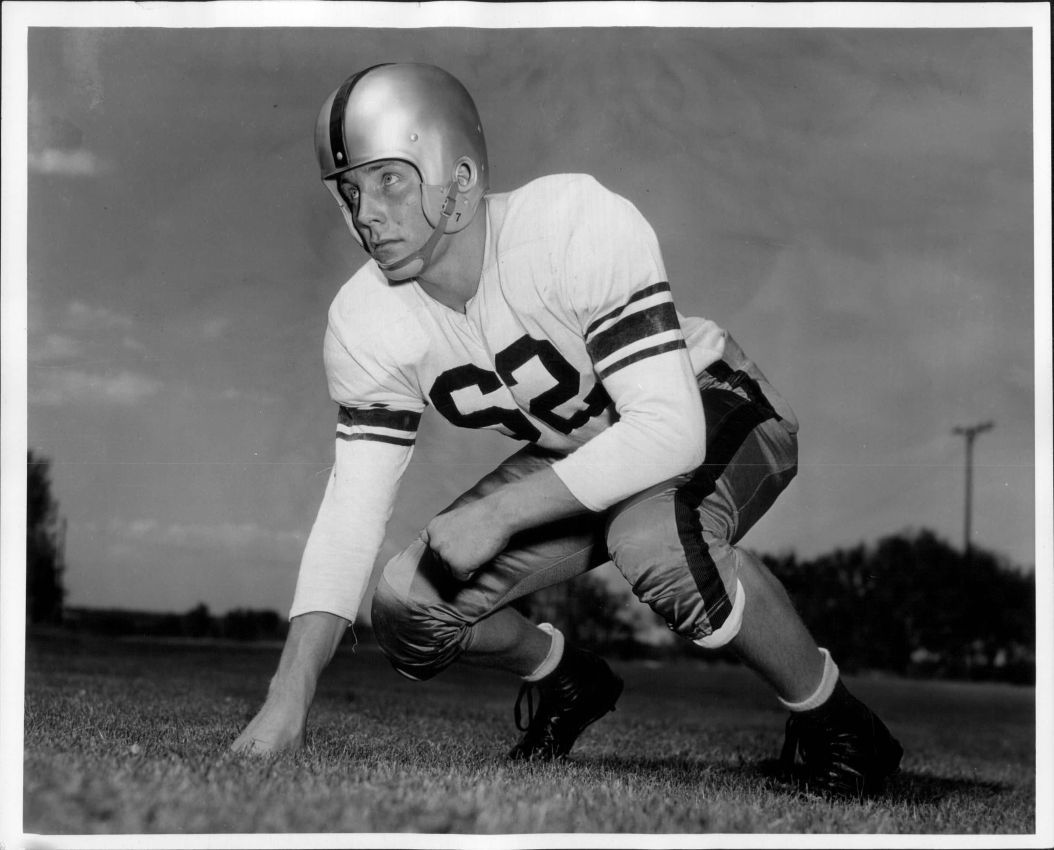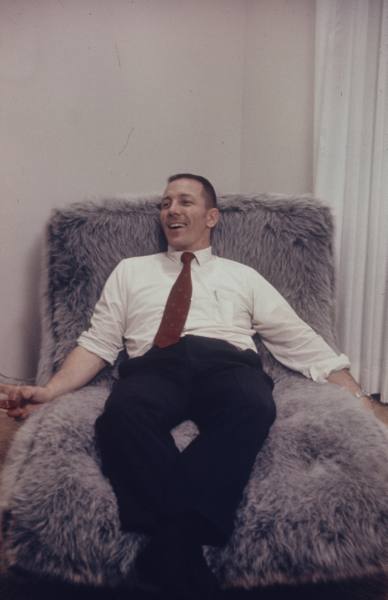
In 2011, waiting for STS-133 to launch on a sunny February afternoon in Titusville, Fla., an out-of-town visitor inquired about Apollo astronauts while talking to a former Cape worker in the proximity of the U.S. Space Walk of Fame Museum, formerly located on the city’s Main Street. She brings up the name “Jack Swigert,” and an embarrassed giggle erupts from the elderly gentleman. “Well, some of those boys were wilder than others,” the man says, smiling broadly and shaking his head, undoubtedly remembering the long-dead astronaut’s adventures in bachelorhood.
The 1995 Ron Howard movie Apollo 13 stars actor Kevin Bacon as Swigert. The film arcs around him being a space “rookie,” and, of course, contains many references to his bachelor status. One of the first times we meet Swigert in the film he’s in the shower with one of his (many) girlfriends, grumbling about having to get the rotary phone because he’s on the backup crew (moments later, the viewer discovers why he’s getting the phone call, as he’s about to ascend to prime crew status because command module pilot Thomas K. Mattingly has been exposed to German measles). So, popular culture established two things about him within minutes of the film: He was an astronaut and a “swinger.” But, we don’t really discover anything notable about Swigert the person.
Who was Jack Swigert? Some digging into newspaper archives and books reveals several sides to the man who left Earth permanently in December 1982. Today, had he survived his fight with cancer, he would have turned 83. Who was Apollo 13’s command module pilot, immortalized in spaceflight history by a missed chance at the Moon?

John Leonard Swigert was born Aug. 30, 1931, in Denver, Colo. According to a 1982 New York Times obituary, his ophthalmologist father strongly encouraged young “Jack” to become a doctor, but he had no interest in the medical field. Swigert’s mother, Virginia, related, ”[Jack] was interested in mechanical things and would rather tinker with an old car than anything else.”
At age 14, he became fascinated by aviation. While he would’ve been content just watching planes take off from nearby Combs Field, young Jack became determined to do more than be a spectator. He took on a newspaper route to earn money for flying lessons, and by age 16 he was a licensed private pilot. The New York Times article states that his father must have been persuaded by his son’s passion for flying, as he agreed to pay for half of the flying lessons.
He attended East Denver High School and entered the University of Colorado following graduation. Having played varsity football in high school, he also had a strong desire to play during his college years in the late 1940s. However, a 1982 Associated Press article described his athletic drawbacks: He was “a small youth with flat feet.” Just as he’d been determined to earn his pilot’s license, Swigert became a “standout” football player. The same article quotes his former football coach, Dal Ward: “When he first came here, I never dreamed he’d be on the first team. That next fall, he started out on the fifth team, but by the time the season started, he was on the first team.”
Swigert earned a degree in mechanical engineering from UC; he also held two master’s degrees (one in aerospace engineering from Rensselaer Polytechnic Institute and a Master of Business Administration degree from the University of Hartford). Following his graduation from UC, he joined the U.S. Air Force, where he trained as a pilot. During his military career, he was deployed to Japan and Korea. In the latter nation, he would experience his first brush with death. According to the New York Times, “In 1953, his plane crashed into a radar unit on a Korean airstrip and burst into flames.” He walked away from the accident unscathed. This wouldn’t be the first time he narrowly escaped a dangerous situation.
Swigert served with the Massachusetts Air National Guard (1957–1960) and the Connecticut Air National Guard (1960–1965). He also worked as a pilot for Pratt & Whitney and North American Aviation. During this period, his eye was drawn to a new challenge: the Space Race. He was once again determined to meet this challenge head-on.
Swigert applied to be a NASA astronaut in 1962 and 1963 respectively, for the second and third astronaut groups. However, he was rejected each time. These rejections inspired him to further his education, and in 1966 he finally got the nod from NASA. In 1982, he was quoted as saying, “I’m a fighter, not a quitter. Look what I did to get into the space program.”

Swigert, unlike his colleagues, was not married; it was said he kept a well-organized “little black book” with phone numbers of his prospective dates and was once quoted by his sister as having “a girl in every port.” The book Falling to Earth, written by Astronaut Group Five colleague Al Worden with Francis French, has a humorous story about Swigert the bachelor … and spendthrift:
“A lifelong bachelor, Jack had a party at his house every weekend and dated every woman in sight. He was a real skirt chaser and playboy. He spent a lot of time in Miami, where Eastern Airlines had a flight attendant school. I guess the odds of dating were much better around all of those young women. He was also notoriously tight with money, asking a girl out on a date only to have her pay … All of this behavior was generally considered okay; no one cared about Jack’s private life as long as he did his job as well. Thankfully, he was very good at what he did. He’d been a fighter pilot and a great test pilot before joining NASA and was well regarded in the flying fraternity.”
Following the Apollo 1 fire in 1967, Swigert, along with Worden, was employed to work on the Apollo Block II spacecraft. During this period, he became an expert about command module contingencies, which would serve him well in April 1970. In 1968, he served as a member of Apollo 7’s support crew and was a CAPCOM for that mission. And in 1970, he got his unexpected moment in space while serving on Apollo 13’s backup crew (Apollo 16’s prime crew).
The events surrounding Apollo 13 in April 1970 are well-known, and Swigert once again came close to losing his life; had the same sequence of events unfolded while Jim Lovell and Fred Haise were walking on the Moon, all three crew members would have certainly perished. The three men returned to Earth on April 17 and received the “glossy mag” treatment from LIFE magazine, among other publications. One infamous photo shows Swigert in his furry purple recliner, highball glass in hand, seemingly without a care in the world. However, as the 1970s and 1980s unfolded, he would encounter yet more adversity.
Swigert was meant to fly on 1975’s Apollo-Soyuz (ASTP) mission, but this opportunity was scuttled by a scandal that rocked another Apollo crew. Following the Apollo 15 postage stamp controversy, Swigert denied he’d had any dealings involving envelopes, but later admitted he had. The book, Deke!, written by Donald K. “Deke” Slayton with Michael Cassutt, details the end of Swigert’s spaceflight career: “[Swigert’s admission] was enough for George Low, who was having to deal with this. Jack Swigert wasn’t going to be on ASTP.” In 1973, his chances to fly gone, he became the executive director of the U.S. House Committee on Science and Technology. His determined gaze turned to politics.
A staunch Republican, Swigert first entered the political arena in 1978, when he campaigned for a seat in the U.S Senate. Despite losing to friend William Armstrong in the Republican primary, once again he wouldn’t quit. In 1982, he began campaigning for a U.S. House seat. But mid-campaign, he would face his biggest challenge of all—even bigger than ones encountered half a world away in Korea, or 240,000 miles away, around the Moon.

According to a Denver Post article published in November 1982, Swigert had a small, cancerous tumor removed from his nose earlier that year, and had received radiation treatment. It was believed this treatment had been successful. But in August 1982, Swigert, suffering severe back pain, was looking pale, thin, and wan, which was not characteristic for him (at nearly six feet tall, he was larger than most Apollo astronauts, and he weighed the most—195 pounds—prior to liftoff). In September, he underwent medical tests; a bone marrow biopsy would reveal lymphoma.
Despite this crushing diagnosis, Swigert wouldn’t end his campaign. The Denver Post article relayed his words: “A few days ago I learned I have a new challenge. Like three million other Americans, I have cancer, and I believe you need to know that. For a while, I may have to work only eight or nine hours a day, but I will continue my aggressive campaign.” For the next few months, he fought a war on two fronts. He won his political battle in Colorado with 63 percent of the vote. He would continue his war with cancer, but sadly, on Dec. 27, he succumbed to pneumonia at the obscenely young age of 51.
While Swigert the man was gone, the image of him as a bachelor who suddenly ascended to dizzying heights remained, particularly in Apollo 13. Swigert’s posthumous life certainly has more meaning than that. A school in Colorado bears his name and dedication to spaceflight (Jack Swigert Aerospace Academy), while a bronze statue bearing his likeness is on display in Washington, D.C.’s Capitol Visitors Center (a duplicate bronze is featured at Denver International Airport).
Who was Jack Swigert? He was a test pilot, astronaut, politician, and bachelor who may have liked a good party or two. But ultimately, he was a fighter who didn’t surrender, despite encountering tremendous adversity. Before his death, he said: “I believe God measures your life. He puts you on Earth, gives you talents and certain opportunities, and, I think, you’re going to be called to account for those opportunities.” Despite facing setbacks, Jack Swigert certainly earned his place in history’s canon.
Want to keep up-to-date with all things space? Be sure to “Like” AmericaSpace on Facebook and follow us on Twitter: @AmericaSpace




Nice piece. Happy Birthday among the stars….
The stars are once again your birthday candles. Happy birthday !!